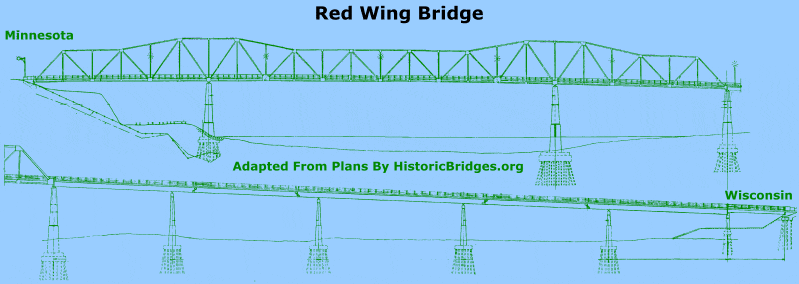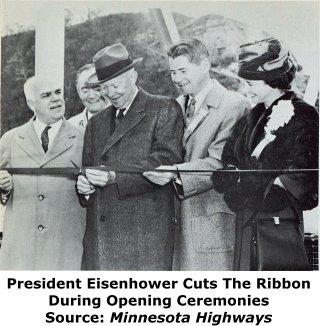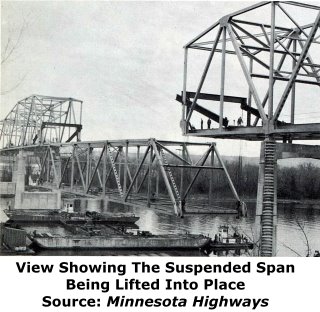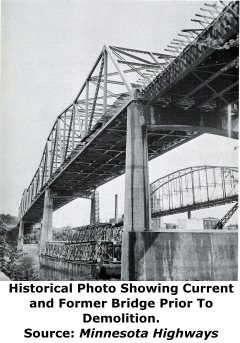We Recommend:
Bach Steel - Experts at historic truss bridge restoration.
BridgeHunter.com Phase 1 is released to the public! - Visit Now
Red Wing Bridge
Eisenhower Bridge
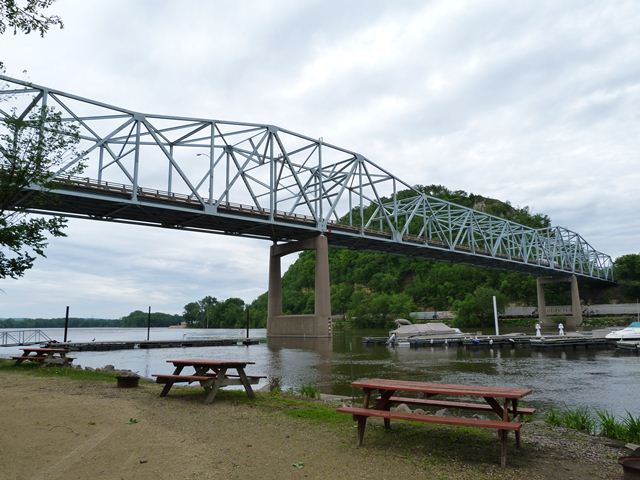
Primary Photographer(s): Nathan Holth
Bridge Documented: June 4, 2013
Red Wing and Pucketville: Goodhue County, Minnesota and Pierce County, Wisconsin: United States
Metal Cantilever Rivet-Connected Warren Through Truss, Fixed and Approach Spans: Metal Pin and Hanger Deck Girder, Fixed
1958 By Builder/Contractor: Industrial Construction Company and Engineer/Design: Alfred Benesch and Associates of Chicago, Illinois
Not Available or Not Applicable
432.0 Feet (131.7 Meters)
1,631.0 Feet (497.1 Meters)
30 Feet (9.14 Meters)
3 Main Span(s) and 6 Approach Span(s)
9040

View Information About HSR Ratings
Bridge Documentation
This bridge no longer exists!
Bridge Status: Demolished and replaced February 6, 2020.View Archived National Bridge Inventory Report - Has Additional Details and Evaluation
View Original Plans For This Bridge
View Historical Articles About Bridge
This bridge is a late, but unaltered and increasingly rare example of a cantilever through truss bridge. The bridge displays the simpler details of a mid-20th Century truss bridge, including limited use of built-up beams, and a total lack of v-lacing or lattice. The bridge does display all-riveted construction however. Had this bridge been built a few years later, the connections might have been bolted. The bridge also includes a series of deck girder approach spans which feature cantilevered beams connected by a pin and hanger detail.
The bridge was designed by Alfred Benesch of Chicago, a consulting engineer that built a noteworthy number of truss bridges in the 1950s and 1960s.
Based on a review of the original shop plans, Allied Structural Steel Companies of Chicago, Illinois was the steel contractor for the bridge, and they completed the steel work for a company named Industrial Construction Company, which was presumably the on-site general contractor.
This bridge is currently slated for demolition and replacement by MnDOT. The project website makes a big deal about the fact that this bridge is fracture critical. This, despite the fact that research has shown that fracture critical bridges are safe if routinely maintained and inspected (an expectation that should exist for all bridges). However, many DOT's like to condemn bridges using the fracture critical excuse. HistoricBridges.org did not find any serious deterioration on this bridge that could not be fixed through rehabilitation. Rehabilitation would doubtless cost vastly less than the option of demolition and replacement that MNDOT has chosen. It is unclear why taxpayer dollars are being wasted on replacing a bridge that is feasible to rehabilitate. The money saved by rehabilitation could be used to preserve additional bridges, pave roads, etc. Instead, MNDOT has taken on a misleading claim that the existing historic bridge if rehabilitated would cost more to maintain in the future. This is a silly statement to make. If the replacement bridge is built of pre-stressed concrete, it will be built of a material extremely susceptible to rapid deterioration following the formation of even very small cracks. If the replacement bridge is built of steel, it will have to be painted and protected from rust just like the existing bridge. Finally, the existing bridge's two lanes appear sufficient for traffic volumes. It is not apparent that more lanes are needed. Moreover, the proposed replacement bridge will also be two lanes. This indicates that replacement is not needed to increase traffic volume capacity.
A historic overpass is immediately southeast of this bridge.
![]()
Photo Galleries and Videos: Red Wing Bridge
Bridge Photo-Documentation
Original / Full Size PhotosA collection of overview and detail photos. This gallery offers photos in the highest available resolution and file size in a touch-friendly popup viewer.
Alternatively, Browse Without Using Viewer
![]()
Bridge Photo-Documentation
Mobile Optimized PhotosA collection of overview and detail photos. This gallery features data-friendly, fast-loading photos in a touch-friendly popup viewer.
Alternatively, Browse Without Using Viewer
![]()
Maps and Links: Red Wing Bridge
This historic bridge has been demolished. This map is shown for reference purposes only.
Coordinates (Latitude, Longitude):
Search For Additional Bridge Listings:
Bridgehunter.com: View listed bridges within 0.5 miles (0.8 kilometers) of this bridge.
Bridgehunter.com: View listed bridges within 10 miles (16 kilometers) of this bridge.
Additional Maps:
Google Streetview (If Available)
GeoHack (Additional Links and Coordinates)
Apple Maps (Via DuckDuckGo Search)
Apple Maps (Apple devices only)
Android: Open Location In Your Map or GPS App
Flickr Gallery (Find Nearby Photos)
Wikimedia Commons (Find Nearby Photos)
Directions Via Sygic For Android
Directions Via Sygic For iOS and Android Dolphin Browser
USGS National Map (United States Only)
Historical USGS Topo Maps (United States Only)
Historic Aerials (United States Only)
CalTopo Maps (United States Only)

